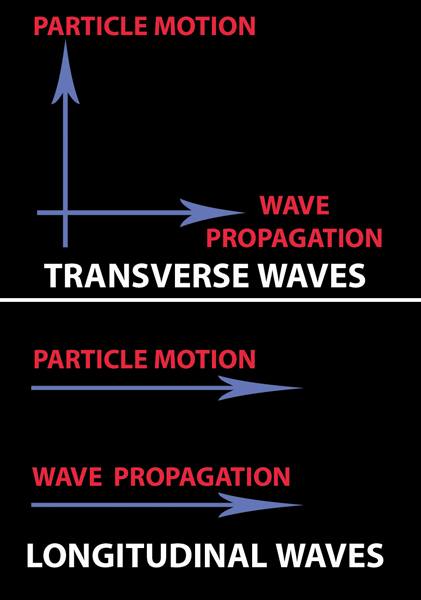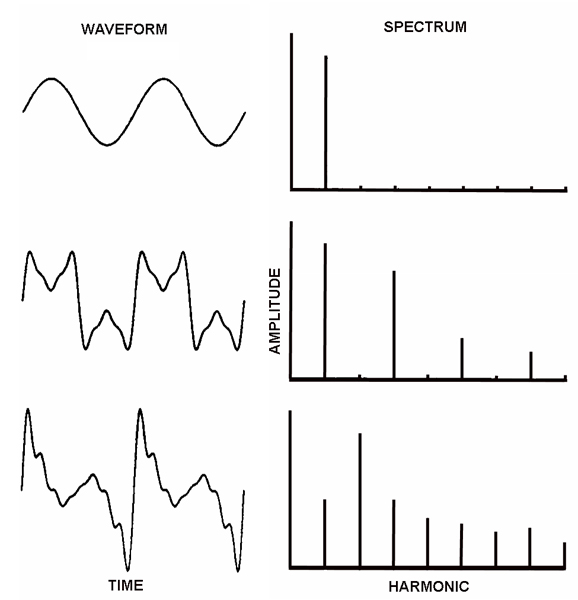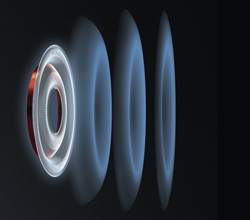Previously (here and here), we’ve been looking at sound on a “microscopic” level, examining particle motion as sound propagates through air.
This time, let’s look at a larger picture of sound wave propagation.
A vibrating object will disturb the surrounding air medium causing localized changes in pressure and particle displacement with the transference of acoustical energy in the form of a sound wave.
Waves can be broadly classified as being either transverse or longitudinal. The distinction for each wave type corresponds to the relationship to which direction the particles in the medium move relative to the direction the wave moves.
For a transverse wave, the particles of the medium move at right angles to the direction of the wave propagation.
Examples of transverse waves include ocean waves, vibrating strings on a musical instrument, and light and other electro-magnetic radiation.
For a longitudinal wave the direction of the wave propagation is parallel (same direction) as the motion of the medium particles.
Sound waves in air are unique in that they propagate as longitudinal waves. Figure 1 shows concepts for transverse and longitudinal wave motion.

A sound wave in air will propagate away from a source as a wavefront with the speed of 343 m/s. The sound particle vibrations travel outward from the source with the same phase. Sources can take the form of simple geometry, called point or monopole (e.g., single loudspeaker or small hole in a wall), line (e.g., moving vehicular traffic or many closely spaced loudspeakers), plane (e.g., top plate of double bass, large building surfaces, or large two dimensional loudspeaker array), or complex comprising two or more simple sources (e.g., musical instrument or machine).
The wavefront takes on a spherical geometry at a distance from the source that is larger than the source dimensions and are called spherical waves. At farther distances the wavefronts appear to be flat (planar) and are called plane progressive waves. Plane waves are sound waves in the simplest form.
The opposite of a plane progressive wave is the standing wave. And yet another wave type is the cylindrical wave, due to a series of point sources radiating in-phase with each other that results in a line source.
SIMPLE MULTIPLES
Waves, regardless of whether spherical, cylindrical, or plane, can be considered to be simple or complex. A simple wave is a wave that comprises only one frequency, such as a sinusoid. A complex wave comprises a fundamental sinusoid and harmonics, with the harmonics either being simple integer multiples (2, 3, 4…etc.) of the fundamental sinusoid or non-integer multiples (1.35, 2.21, 3.05 etc.), as occurs for many percussion instruments.
Through a mathematical process called Fourier Analysis, we can decompose a complex wave into the fundamental and harmonic frequencies, their relative amplitudes, and phase relationships. Figure 2 shows a Fourier analysis of simple and complex waves.

Two or more simple or complex sound waves can combine with each other through an additive process called the law of superposition. The resulting complex wave, assuming that the waves are linearly related, is the sum of the displacements due to each sound source.
Sound waves are linearly related when each is directly proportional to displacement. Non-linear acoustic behavior typically occurs when the source sound pressure level exceeds 140 dB.
While conceptually simple, the law of superposition is complex since the particle displacement (ξ) and particle velocity (u) of each sound wave may not always be in the same direction because the sound waves can arrive from any arbitrary location. Remember too, that particle displacement and particle velocity are functions of time and frequency.
Thus, the law of superposition requires a vector summation of waves. Waves from opposite directions will add momentarily together at a finite point in space and then pass through each other as the wavefronts continue propagating in their respective directions.
Waves can add constructively, resulting in greater amplitude, or destructively, resulting in reduced amplitude. The law of superposition describes this. What determines the resultant amplitude through constructive or destructive addition is the relative phase of the waves.
Waves that are perfectly in-phase (0-degree phase difference) add together with no destructive behavior. Waves that are perfectly out-of-phase (180-degree phase difference) add together to result in effectively zero amplitude. Most complex waves have phase relationships that vary as a function of frequency and do not combine in such simple relationships as described above.














